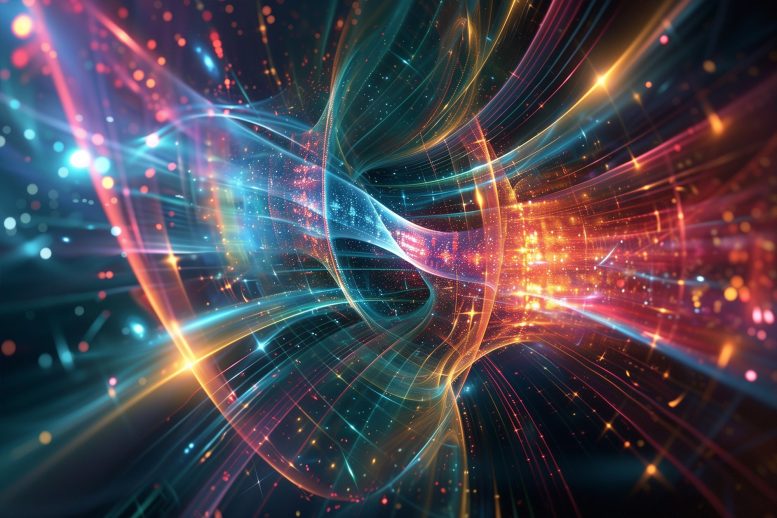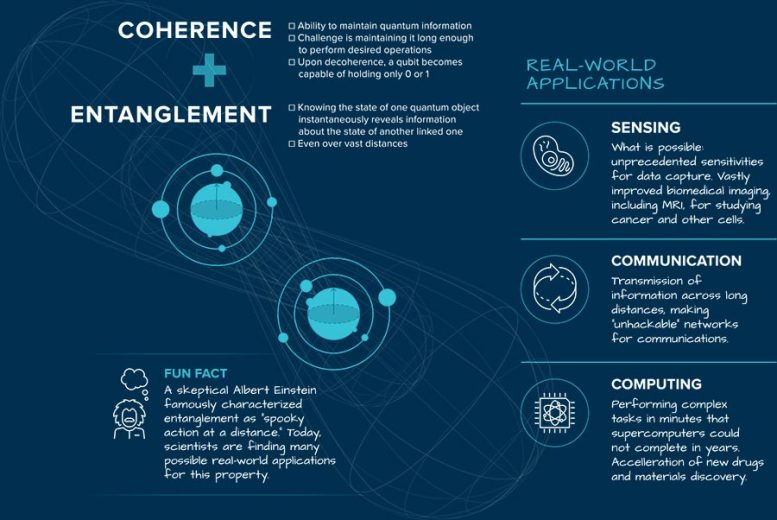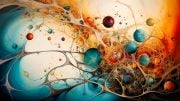
Quantum mechanics, a field of physics exploring the fundamental nature of matter and energy, reveals phenomena like objects existing in multiple states or places, essential for advancing modern technologies and secure communications. Credit: SciTechDaily.com
What Is Quantum Mechanics?
Imagine a world where objects can seem to exist in two places at once or affect each other from across the universe.
Although we don’t see these types of things in our everyday lives, similar curiosities appear to exist all around us in the fundamental behavior of our universe and its smallest building blocks. These peculiar characteristics of nature are described by a branch of physics called quantum mechanics.
In this Science 101: What is Quantum Mechanics video, Katherine Harmon – Argonne Scholar in the Materials Science Division – explains what quantum mechanics is. Quantum mechanics is a theory that deals with the most fundamental bits of matter, energy and light and the ways they interact with each other to make up the world. This landmark theory originated in the early 20th century and is finding many real-world applications in the 21st century. Applying quantum mechanics in the laboratory, Argonne scientists like Harmon and many others are developing technologies that could one day transform society and our understanding of the universe. Quantum sensors could detect previously undetectable cancer cells. A quantum internet could ensure unhackable communication of messages and data. Quantum computers could solve complex problems classical computers cannot. Quantum theory will also continue to advance our knowledge of the universe from the intricate dynamics deep within an atom to cosmic events as grand as the birth of the universe.
In the early 1900s, scientists began to develop quantum mechanics in order to explain the results of a number of experiments that defied any other interpretation. Today, scientists use this theory to create powerful technologies — unhackable communication of messages, faster drug discovery and higher-quality images on your phone and TV screens.
So, what is quantum? In a more general sense, the word “quantum” can refer to the smallest possible amount of something. The field of quantum mechanics deals with the most fundamental bits of matter, energy and light and the ways they interact with each other to make up the world.
Unlike the way in which we usually think about the world, where we imagine things to have particle- or wave-like properties separately (baseballs and ocean waves, for example), such notions don’t work in quantum mechanics. Depending on the situation, scientists may observe the same quantum object as being particle-like or wave-like. For example, light cannot be thought of as only a photon (a light particle) or only a light wave, because we might observe both sorts of behaviors in different experiments.
Day to day, we see things in one “state” at a time: here or there, moving or still, right-side up or upside down. The state of an object in quantum mechanics isn’t always so straightforward. For example, before we look to determine the locations of a set of quantum objects, they can exist in what’s called a superposition — or a special type of combination — of one or more locations. The different possible states combine and interfere with each other like waves in a pond, and the objects only have a definite position after we’ve looked. Superposition is one of the main features that make quantum computers possible because it enables us to represent information in new and useful ways.
Another interesting quantum behavior is tunneling, where a quantum object, like an electron, can sometimes pass through barriers it otherwise wouldn’t be able to get through. This happens because superposition allows for a small chance of the electron being on the other side of the barrier. Quantum tunneling has applications such as in flash memory devices, powerful microscopes and quantum computers.
When quantum objects interact, they are linked to each other through a connection called entanglement. This connection holds even if the objects are separated by large distances. Einstein called it “spooky action at a distance.” Scientists are making use of it for ultra-secure communication, and it is an essential feature in quantum computing.
At the U.S. Department of Energy’s (DOE) Argonne National Laboratory, scientists take advantage of world-class expertise and research facilities to develop quantum technologies to store, transport and protect information, and to investigate our universe, from the intricate dynamics deep within an atom to events as grand as the birth of the universe itself. Argonne also leads Q-NEXT, a DOE national quantum information science research center working to develop quantum materials and devices and capture the power of quantum technology for communication.
What Is Quantum Information Science?
Leveraging counter-intuitive behavior on the atomic scale to create powerful changes in information science on a practical scale.
Scientists are racing to develop quantum-based systems that can store, transport, manipulate, and protect information.
Qubits—quantum bits—are the fundamental components of quantum computing and other quantum information systems. They are analogous to the bit in classical computers, either 0 or 1. What makes qubits truly strange is that they can simultaneously be both 0 and 1. This overlapping state gives quantum computers tremendously increased horsepower. The qubit itself can come in many different forms—electrons, particles of light, even tiny defects in otherwise highly structured materials.
Scientists are seeking to design qubits that maintain information in their quantum states for seconds (“coherence”) and can link with other qubits (“entanglement”).
Quantum technologies could transform national and financial security, drug discovery, and the design and manufacturing of new materials, while deepening our understanding of the universe.









Quantum mechanics, a field of physics exploring the fundamental nature of matter and energy, reveals phenomena like objects existing in multiple states or places. Is this your science simplified that what is quantum mechanics?
What are the multiple states or places in quantum mechanics? According to topological vortex gravitational field theory, the simplest multiple states are the left and right rotation of the vortex, and the simplest multiple places are the front and back of the vortex. The physical essence of quantum mechanics is to describe the spin and interaction of 2D topological vortices, rather than a cat that is both dead and alive in high-dimensional spacetime. Quantum gravity comes from the spin of topological vortices.
The universe does not do algebra, formula or fraction. The universe is geometrythe, and is the superposition, deflection, and twisting of geometric shapes.
Today, we have already entered the era of the internet. With the help of artificial intelligence and big data, discussions on scientific knowledge have become open and transparent. However, a group of editors of so-called academic journals (such as Physical Review Letters, Nature, Science, etc.) are self-righteous and mystifying themselves. They only care about their own so-called sufficiently high priority rating, general significance, discipline, novelty, etc., and do not care about what science and pseudoscience are.
Science and pseudoscience are not determined by a publication, an organization or a person, nor by you or me, but by mathematics the final say. Physical models must be based on mathematics or mathematical models in order to be scientific, convincing, and in accordance with natural laws.
The origin of geometry lies in the concerns of everyday life. The branch of geometry (mathematics) known as topology has become a cornerstone of modern physics. Topological vortex and antivortex are two bidirectional coupled continuous chaotic systems. They exhibit parity conservation, charge conjugation, and time reversal symmetry. The synchronization effect is extremely important in their interactions. The synchronization effect of the superposition, deflection, and twisting of multiple or countless topological vortices will make spacetime motion more complex. To understand this complex world, physics should respect the authenticity of topological vortex in low dimensional spacetime, rather than simply relying on a few formulas, numbers, or imagined particles.
Spin is a natural property of topological vortices. Spin is synchronized with energy, spin is synchronized with gravitation, spin is synchronized with time, spin is synchronized with evolution. The perpetually swirling topological vortices defy traditional physics’ expectations. One physical properties of topological vortices is them to spontaneously begin to change periodically in time, even though the system does not experience corresponding periodic interference. Therefore, in the interaction of topological vortices, time is both absolute and relative,and physics often requires treating space and time at the same level.
Low-dimensional spacetime matter is the foundation of high-dimensional spacetime matter. Low-dimensional spacetime matter (such as topological vortex) can form new material structures and derive more complex physical properties via interactions and self-organization. It is extremely wrong and irresponsible to imagine low dimensional spacetime matter using high-dimensional spacetime matter,such as a cat in quantum mechanics.
Science must follow mathematical rules. For example, the Standard Model (SM) is considered to be one of the most significant achievements of physics in the 20th century. However, the magnetic moment of μ particle is larger than expected, revealed by a g-2 experiment at Fermilab, suggests that the established theory (such as SM) of fundamental particles is incomplete. Furthermore, the SM omitting gravitation, it not involved the time problem and when the particle movement starts. Mathematics is the foundation of science. Physics must respect the scientific nature of mathematics and mathematical models. The SM must be based on mathematical models in order to be scientific, convincing, and in line with natural laws.
I hope researchers are not fooled by the pseudoscientific theories of the Physical Review Letters (PRL), and hope more people dare to stand up and fight against rampant pseudoscience.
The so-called academic journals (such as Physical Review Letters, Nature, Science, etc.) firmly believe that two high-dimensional spacetime objects (such as two sets of cobalt-60) rotating in opposite directions can be transformed into two objects that mirror each other, is a typical case of pseudoscience rampant.
If researchers are really interested in Science and Physics, you can browse https://zhuanlan.zhihu.com/p/643404671 and https://zhuanlan.zhihu.com/p/595280873.
I am well aware that my relentless repetition can make some people unhappy, but in the fight against rampant pseudoscience, that’s all I can do.
Please think carefully,
1. What are the qubits?
2. Why can qubits simultaneously be both 0 and 1?
3. What is the physical reality of qubits?
and so on.
The Physical Review Letters (PRL) is the most evil, ugly, and dirty publication in the history of science. Nature and Science have been influenced by Physical Review Letters (PRL) and are even more notorious. The behavior of these pseudo-academic publications has seriously hindered the progress and development of human society in science and technology.
… At the end it looks like The God really plays dices… and to be more precise it looks like it liked particular game of, hugh that is French… craps
Very good!
To be precise, what God plays is two spinning coin. However, until you see the coin, you will not be able to determine whether you are seeing a Left-handed or right-handed spin coin.
Best wishes to you.
Therefore, at the moment of Creation, the geometric shapes of matter and antimatter are consistent. It is only the synchronous effect of countless “spinning coin” that makes spacetime motion more complex.
If there really is God, symmetry is God. Symmetry creates the world, symmetry creates all things. The world we see and observe is asymmetric because we can never see or observe the entirety of the world.